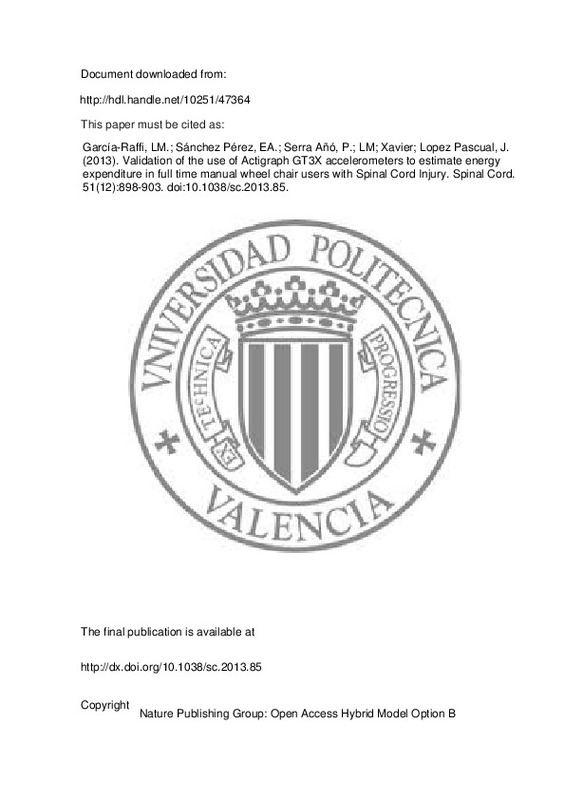Van den Berg-Emons RJ, Bussmann JB, Haisma JA, Sluis TA, van der Woude LH, Bergen MP et al. A prospective study on physical activity levels after spinal cord injury during inpatient rehabilitation and the year after discharge. Arch Phys Med Rehabil 2008; 89: 2094–2101.
Jacobs PL, Nash MS . Exercise recommendations for individuals with spinal cord injury. Sports Med 2004; 34: 727–751.
Erikssen G . Physical fitness and changes in mortality: the survival of the fittest. Sports Med 2001; 31: 571–576.
[+]
Van den Berg-Emons RJ, Bussmann JB, Haisma JA, Sluis TA, van der Woude LH, Bergen MP et al. A prospective study on physical activity levels after spinal cord injury during inpatient rehabilitation and the year after discharge. Arch Phys Med Rehabil 2008; 89: 2094–2101.
Jacobs PL, Nash MS . Exercise recommendations for individuals with spinal cord injury. Sports Med 2004; 34: 727–751.
Erikssen G . Physical fitness and changes in mortality: the survival of the fittest. Sports Med 2001; 31: 571–576.
Warburton DER, Nicol CW, Bredin SSD . Health benefits of physical activity: the evidence. CMAJ 2006; 174: 801–809.
Haennel RG, Lemire F . Physical activity to prevent cardiovascular disease. How much is enough? Can Fam Physician 2002; 48: 65–71.
Manns PJ, Chad KE . Determining the relation between quality of life, handicap, fitness, and physical activity for persons with spinal cord injury. Arch Phys Med Rehabil 1999; 80: 1566–1571.
Hetz SP, Latimer AE, Buchholz AC, Martin Ginis KA . Increased participation in activities of daily living is associated with lower cholesterol levels in people with spinal cord injury. Arch Phys Med Rehabil 2009; 90: 1755–1759.
Buchholz AC, Martin Ginis KA, Bray SR, Craven BC, Hicks AL, Hayes KC et al. Greater daily leisure time physical activity is associated with lower chronic disease risk in adults with spinal cord injury. Appl Physiol Nutr Metab 2009; 34: 640–647.
Slater D, Meade MA . Participation in recreation and sports for persons with spinal cord injury: review and recommendations. Neurorehabilitation 2004; 19: 121–129.
Valanou EM, Bamia C, Trichopoulou A . Methodology of physical-activity and energy-expenditure assessment: a review. J Public Health 2006; 14: 58–65.
Liu S, Gao RX, Freedson PS . Computational methods for estimating energy expenditure in human physical activities. Med Sci Sports Exerc 2012; 44: 2138–2146.
Troiano RP, Berrigan D, Dodd KW, Mâsse LC, Tilert T, McDowell M . Physical activity in the United States measured by accelerometer. Med Sci Sports Exerc 2008; 40: 181–188.
Riddoch CJ, Bo Andersen L, Wedderkopp N, Harro M, Klasson-Heggebø L, Sardinha LB et al. Physical activity levels and patterns of 9- and 15-yr-old European children. Med Sci Sports Exerc 2004; 36: 86–92.
Hiremath SV, Ding D . Evaluation of activity monitors in manual wheelchair users with paraplegia. J Spinal Cord Med 2011; 34: 110–117.
Hiremath SV, Ding D . Evaluation of activity monitors to estimate energy expenditure in manual wheelchair users. Conf Proc IEEE Eng Med Biol Soc 2009; 2009: 835–838.
Washburn R, Copay A . Assessing physical activity during wheelchair pushing: validity of a portable accelerometer. Adapt Phys Activ Q 1999; 16: 290–299.
Hiremath SV, Ding D . Regression equations for RT3 activity monitors to estimate energy expenditure in manual wheelchair users. Conf Proc IEEE Eng Med Biol Soc 2011; 2011: 7348–7351.
Hiremath SV, Ding D, Farringdon J, Cooper RA . Predicting energy expenditure of manual wheelchair users with spinal cord injury using a multisensor-based activity monitor. Arch Phys Med Rehabil 2012; 93: 1937–1943.
Bassett DR Jr, Ainsworth BE, Swartz AM, Strath SJ, O’Brien WL, King GA . Validity of four motion sensors in measuring moderate intensity physical activity. Med Sci Sports Exerc 2000; 32: S471–S480.
Motl RW, Sosnoff JJ, Dlugonski D, Suh Y, Goldman M . Does a waist-worn accelerometer capture intra- and inter-person variation in walking behavior among persons with multiple sclerosis? Med Eng Phys 2010; 32: 1224–1228.
Van Remoortel H, Raste Y, Louvaris Z, Giavedoni S, Burtin C, Langer D et al. Validity of six activity monitors in chronic obstructive pulmonary disease: a comparison with indirect calorimetry. PLoS One 2012; 7: e39198.
Macfarlane DJ . Automated metabolic gas analysis systems: a review. Sports Med 2001; 31: 841–861.
Staudenmayer J, Pober D, Crouter S, Bassett D, Freedson P . An artificial neural network to estimate physical activity energy expenditure and identify physical activity type from an accelerometer. J Appl Physiol 2009; 107: 1300–1307.
Daubechies I . Ten Lectures on Wavelets. SIAM, Philadelphia. 1999.
Debnat I . Wavelets and Signal Processing. Birkhauser, Boston. 2003.
Collins EG, Gater D, Kiratli J, Butler J, Hanson K, Langbein WE . Energy cost of physical activities in persons with spinal cord injury. Med Sci Sports Exerc 2010; 42: 691–700.
Lee M, Zhu W, Hedrick B, Fernhall B . Determining metabolic equivalent values of physical activities for persons with paraplegia. Disabil Rehabil 2010; 32: 336–343.
Crouter SE, Clowers KG, Bassett DR Jr . A novel method for using accelerometer data to predict energy expenditure. J Appl Physiol 2006; 100: 1324–1331.
[-]







![[Cerrado]](/themes/UPV/images/candado.png)


